
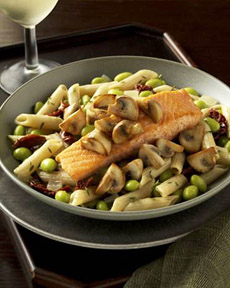 One of the most popular pasta cuts, penne rigate. The tubes are ridged (rigate) to help the sauce adhere. Here, they are served with roasted salmon, sundried tomatoes and edamame. Photo courtesy of MushroomInfo.com. The recipe is on the website.
One of the most popular pasta cuts, penne rigate. The tubes are ridged (rigate) to help the sauce adhere. Here, they are served with roasted salmon, sundried tomatoes and edamame. Photo courtesy of MushroomInfo.com. The recipe is on the website.
Last Updated May 2024
|
 |
Pasta Shapes
Page 6: Pasta Types With P & Q
If you enjoy this Pasta Glossary, we have a food glossary for almost every category of food.
Click on a letter to go to the appropriate glossary page.
a b c d e f g h i j k l m n o p q r s t u v w x y z
This glossary is protected by copyright and cannot be reproduced in whole or part.
PACCHERI and MEZZIPACCHIERI
A large, unridged rigatoni-style tubular pasta (pah-CARE-ee). An unusual cut, typically made only in the area around Naples, that goes with everything from cream sauces to chunky vegetable sauces. It can be cooked at the same time with calamari to make a single dish. Mezzipacchieri are half the length.
|
PAGLIA E FIENO
Paglia e fieno (PAHL-ya eh FYAY-no) is Italian for “straw and hay,” a pasta dish made of yellow tagliatelle (egg noodles), the straw, and green tagliatelle, the hay (colored by adding spinach to the dough). It can be served with any sauce but is often served with cream sauce or tomato sauce.
|
|
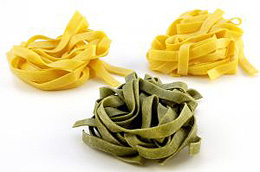
Paglia e fieno. Photo courtesy SXC. |
|
PAPPARDELLE
The classic broad egg noodle (about 3/4" wide), originally from Tuscany. Pappardelle (pah-pahr-DELL-lay) are most commonly served with meat sauces, especially those from game meats like hare or wild boar.
|
|
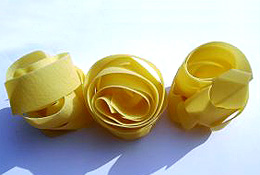
Pappardelle. Photo of courtesy SXC. |
|
PANSOTTI
Pansotti (pon-SUH-tee) are triangular-shaped ravioli, generally found with crimped edges. The word is Italian for “pot-bellied.”
PASTA
The Italian word for noodles. Like the German word nudel, it means paste: Pasta is made from a paste of flour and water. Italian-style pasta is made specifically from durum wheat plus water, salt, and sometimes eggs (pasta all’uovo, egg noodles). The term refers to all shapes of pasta, from long cuts like spaghetti, shaped pasta like fusilli (corkscrews), stuffed pasta like ravioli, and tubular pasta like penne. Pastas are eaten plain, with sauce, in soups, and in casseroles. See also noodles. A half-cup serving of cooked semolina pasta contains one gram of fat, 106 calories, and five milligrams of sodium, protein, and nutrients including B vitamins and iron.
|
|
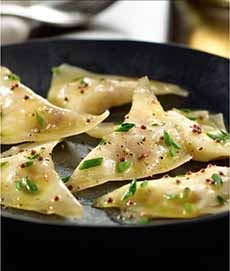
Above, a dish of pansotti. Below, colorful pansotti from Nuovo Pasta. Read our review of Nuovo Pasta, a NIBBLE Top Pick Of The Week.
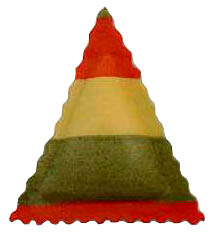
|
PASTA ALL’UOVO
See egg pasta.
PASTA CARBONARA
See carbonara.
PASTA FRESCA & PASTA SECCA
In Italy, pasta fresca is fresh pasta and pasta secca is dried pasta. In Italy, all pasta is made from hard wheat (durum).
|
PASTA DI SEMOLA DI GRANO DURO
Literally, pasta from durum wheat grain. One of two categories of Italian commercial pasta (American classifications echo the Italian), made only with semolina, water and salt. The other category, pasta all’uovo or egg pasta, adds eggs. For the most part, egg pastas are flat ribbons of varying width, from thin linguini to broad lasagna; whereas regular pasta comes in all shapes and sizes, including specialty pastas and buckwheat pastas.
PASTA E FAGIOLI
Cannellini bean soup with ditalini pasta, celery, carrots and tomatoes (PAH-sta eh fah-JOE-lee). In Sicilian American dialect, this dish sounds like “pasta fazool,” a corruption of the Sicilian pronunciation, fah-JOLE. The bean, cannellini, should not be confused with the pasta, cannelloni.
|
|
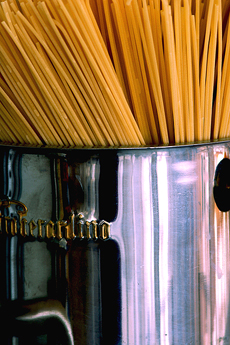 Dried linguine. Photo courtesy SXC. Dried linguine. Photo courtesy SXC. |
|
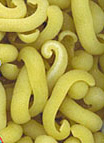 PASTA REGIONALE PASTA REGIONALE
A curl-shaped pasta (PAH-sta REH-joe-NAH-lay—photo at left).
PASTA SHELLS
See conchiglie and photo at righg.
PASTIFICIO
A pasta maker, whether an individual or a factory (pah-stih-FEE-tsee-oh).
|
|
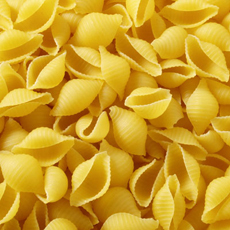
Pasta shells. Photo courtesy BarillaUS.com. |
|
PASTINA
Tiny pasta stars, the smallest pasta shape made (the name means “little pasta” or “little dough”). It is often served in broth or soup, and is generally a child’s first introduction to pasta. However, it can be used in sophisticated recipes, such as timbales and to stuff baby pumpkins. It is available in regular wheat and egg varieties. Pronounced pah-STEE-nah.
|
|
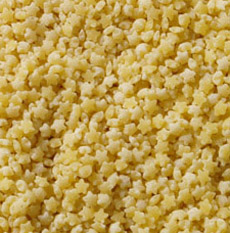
Pastina. Photo courtesy of BarillaUS.com. |
|
PENNE
Penne (PEN-nay) is one of the most famous and popular pasta shapes, a specialty of the Campania region in southern Italy. The Italian word for “quills” or feather pens, penne are large (2-inch), straight tubes cut on the diagonal, to resemble the point of a quill. They can be ridged (rigate) to better hold the sauce (see photo at the top of the page). Penne is one of the most versatile cuts: It compliments most types of sauce, both creamy and heavy, plus oven-baked (al forno) dishes. Penne all’Arrabbiata, with a spicy tomato sauce that includes garlic, basil, and hot chile pepper, is a classic dish. (Arrabbiata means “angry” in Italian.)
PENNE RIGATE
Penne with ridges (PEN-nay rih-GAH-tay—see at right). This shape is an excellent sauce-grabber. The hollows of the pasta hold the sauce on the inside and the ridges hold it on the outside.
|
|
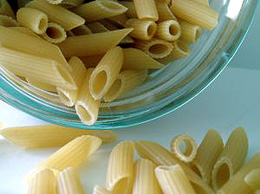
Penne rigate. Photo courtesy SXC.
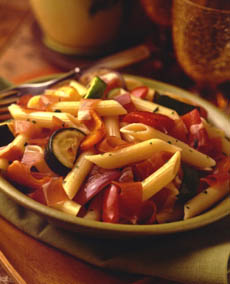
Here’s one of the most popular pasta cuts, penne rigate. The tubes are ridged (rigate) to help the sauce adhere. Photo courtesy of ParmaHam.com (the recipe is on the website). |
|
PENNETTE
Small penne pasta (pen-NEH-teh). Photo at right.
PENNONI
Literally, “big quills” and “big penne”: penne means “quills” and oni means “big.” The ends of this tubular pasta are cut at an angle to look like quill pens.
|
|
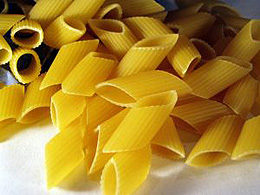
Pennette. Photo courtesy SXC. |
PERCIATELLI
A thick strand pasta like bucatini and perciatelli (pehr-cha-TELL-lee) are fat, hollow strands of pasta. The name comes from a southern Italian dialect word, “perciato,” meaning “pierced through.” A hearty pasta, it is typically served with creamy sauces, lighter tomato sauces, or simply tossed with olive oil.
PESTO SAUCE
Pesto, one of the most famous Italian sauces, is made of basil, garlic, Parmigiano-Reggiano and Pecorino cheeses, olive oil, pine nuts, and salt as needed. It is traditionally ground with a mortar and pestle. The word pesto is the past participle of the Italian word for “to pound or crush.” The sauce originated in Genoa, and is known as pesto alla genovese. Other pestos are made with spinach or arugula instead of basil; walnuts or other nuts instead of pine nuts, etc. Read more in our article on pesto sauce.
|
|
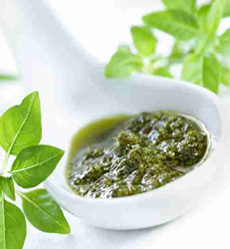
Pesto. Photo | Fotolia.
|
PEZZOCHERI
Buckwheat pasta, is a specialty of the Valtelline Valley in the north of Lombardy, bordering Switzerland. Traditionally a winter dish, it is served with cabbage and potatoes, seasoned with garlic, and baked with cheese.
PICI
Pici is a thick, hand-rolled pasta, like the thickest spaghetti (some say it looks like worms). It is always a fresh pasta (i.e., not dried and packaged). The cut originated in the province of Siena, in Tuscany, Italy. Sometimes, finely chopped spinach is added. The thickness creates a chewy experience. It is popular served as carbonara or cacio e pepe, and also with breadcrumbs, ragù, and porcini mushrooms. It is historically paired with game, such as duck, hare, and wild boar.
|
|
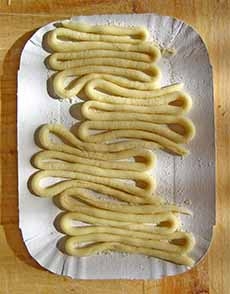
Hand-rolled pici, the fattest spaghetti-style pasta (photo © Fugzu | Wikipedia).
|
PIEROGI or PEROGI
Half-moon-shaped noodle dumplings that look like Italian agnolotti, these Polish and Russian noodle dumplings are filled variously with minced meat, cheese, mushrooms, cabbage, potatoes, or rice. First boiled, they then can be sautéed in butter and topped with toasted breadcrumbs. They are served as a first course or a side dish. Here’s the history of pierogies.
PILLOW PASTA
Another term for ravioli and similar stuffed pasta, is also called pasta pillows.
|
|
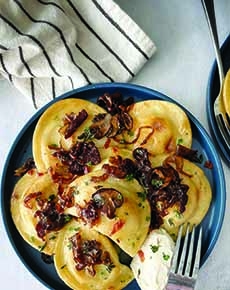
Pierogies with caramelized onions and sour cream (photo © Mrs. T’s).
|
POTSTICKERS
Potstickers are crescent-shaped Asian dumplings, most popular in the north of China. They’re variously stuffed with meat, seafood, or vegetables. In Mandarin, they are called jiaozi, which literally means “stuck to the wok.” They are made with wheat flour dough, which is rolled out thin so it crisps up nicely. They can be boiled, steamed, pan fried or deep fried.
The legend about the origin of jiaozi is that a chef was boiling jiaozi in a wok, but when he stepped away the water boiled off and the jiaozi stuck to the wok. They crisped up, producing a delightful alternative to boiled and steamed dumplings. And thus the name potsticker, “stuck to the wok.”
Gyoza are the Japanese version of potstickers. Japanese soldiers encountered jiaozi when they were in Manchuria during World War II. Upon their return home, they recreated the delicious dumplings they’d had in China.
|
|
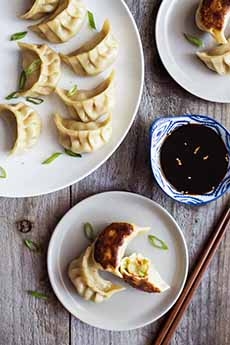
Fried potstickers (photo © Idaho Potato Commission).
|
PUGLIA
A region in southeastern Italy bordering the Adriatic Sea in the east, the Ionian Sea to the southeast, and the Strait of Otranto and Gulf of Taranto in the south. Its southern portion, a peninsula known as Salento, is the heel of the “boot” of Italy. The capital is Bari, and other provinces are Brindisi, Foggia, Lecce, and Taranto.
|
|
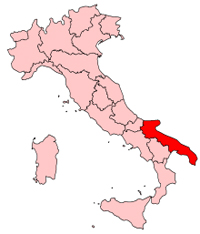
Map of Puglia. Image courtesy
Wikipedia.
|
PUNTALETTE
Similar to orzo, puntalette (poon-tah-LEH-tay, meaning tiny tips in Italilan) are rice-shaped pasta used for soups. They are members of the minute pasta family, meant to be cooked in broth. This shape, which has a double point, was likely invented to appeal to small children. It is especially good in clear soups—broths or consommé— enhanced with julienned or diced vegetables. It can be used in thick creamy or velvety soups. The shape is also called risoni (“big rice”) among other names. Orzo itself means barleyin Italian, as the pasta shape resembles a grain of barley (or rice). |
|
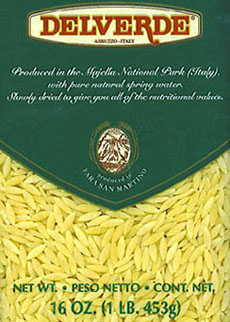
A box of puntalette (photo © Delverde).
|
QUADRUCCI
A category of pasta in the shape of a tube. Tubular pastas are available in many different sizes. Some tubes are long and narrow while others are short and wide. They can have smooth or grooved exteriors; their ends can be cut straight or at an angle. They work especially well with heavier sauces, which catch in the hollows of the tubes. Some of the larger tubes like manicotti can be stuffed with meat and/or cheese and then baked. Among the smallest is elbow macaroni, often used for the popular dish, baked macaroni and cheese.
|
|
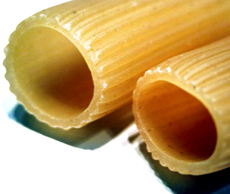
Manicotti tubes. Photo courtesy
MorgueFile.
|
Continue To Next Page: Terms Beginning With R
Go To The Glossary Alphabet Index, Above
© 2005-

|






















